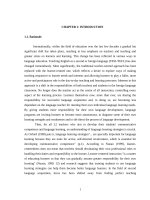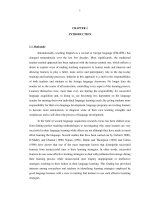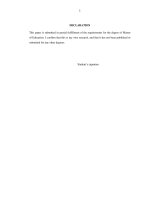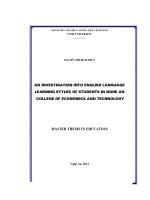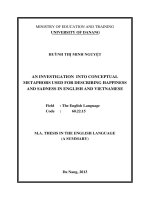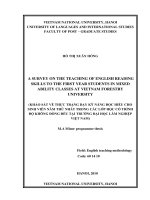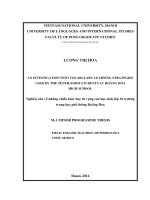An investigation into english reading strategies employed by first year students in honors program at vietnam national university of agriculture
Bạn đang xem bản rút gọn của tài liệu. Xem và tải ngay bản đầy đủ của tài liệu tại đây (1.26 MB, 75 trang )
VIETNAM NATIONAL UNIVERSITY, HANOI
UNIVERSITY OF LANGUAGES AND INTERNATIONAL STUDIES
FACULTY OF POST-GRADUATE STUDIES
TRẦN THI ̣THU HIỀN
AN INVESTIGATION INTO ENGLISH READING STRATEGIES
EMPLOYED BY FIRST-YEAR STUDENTS IN HONORS PROGRAM
AT VIETNAM NATIONAL UNIVERSITY OF AGRICULTURE
(Nghiên cứu những chiế n lươ ̣c đo ̣c hiể u tiế ng Anh của sinh viên năm thứ
nhấ t hê ̣chấ t lươ ̣ng cao ta ̣i Ho ̣c viêṇ Nông nghiêp̣ Viêṭ Nam)
M.A. MINOR PROGRAMME THESIS
Field: English Teaching Methodology
Code: 60140111
Hanoi – 2015
VIETNAM NATIONAL UNIVERSITY, HANOI
UNIVERSITY OF LANGUAGES AND INTERNATIONAL STUDIES
FACULTY OF POST-GRADUATE STUDIES
TRẦN THI ̣THU HIỀN
AN INVESTIGATION INTO ENGLISH READING STRATEGIES
EMPLOYED BY FIRST-YEAR STUDENTS IN HONORS PROGRAM
AT VIETNAM NATIONAL UNIVERSITY OF AGRICULTURE
(Nghiên cứu những chiế n lươ ̣c đo ̣c hiể u tiế ng Anh của sinh viên năm thứ
nhấ t hê ̣chấ t lươ ̣ng cao ta ̣i Ho ̣c viêṇ Nông nghiêp̣ Viêṭ Nam)
M.A. MINOR PROGRAMME THESIS
Field: English Teaching Methodology
Code: 60140111
Supervisor: Dr. Nguyễn Huy Kỷ
Hanoi - 2015
DECLARATION
This paper is submitted in partial fulfillment of the requirements for The
Degree of Master in English Teaching Methodology. I confirm that this is my own
research, and that it has not been published or submitted for any other degrees.
Hanoi, 2015
Trầ n Thi Thu
Hiề n
̣
i
ACKNOWLEDGEMENTS
I would like to acknowledge the contributions of the following people whose
help and guidance have encouraged me to complete this thesis.
First and foremost, I wish to express my deepest gratitude to my admirable
supervisor, Dr. Nguyễn Huy Kỷ, whose patience, prompt consultancy and
encouragement were the most essential factors to the fulfillment of this research.
Secondly, I also counted myself as fortunate to have the six students (S1, S2,
S3, S4, S5 and S6) as my research participants. Without much of their time devoted
to several survey and think-aloud procedures, this thesis would not have been
finished.
Thirdly, I must also express my most sincere appreciation to my colleagues
who have assisted me with data analysis and useful advice.
Lastly, my heartfelt gratitude goes to my beloved parents and husband whose
constant support and patience have encouraged me through the most difficult times.
ii
ABSTRACT
The present study explores reading strategies used by the first-year students
in Honors program at Vietnam National University of Agriculture and find out the
differences in strategy use by successful readers and less successful readers. Six
first-year students were chosen as the participants. The research instruments were
questionnaires and think-aloud reports. Metacognitive was found to be more
preferred than Cognitive by both groups. Successful readers reported utilizing
metacognitive and cognitive categories more frequently and employed a wider
range of reading strategies than less successful readers. Also, significant differences
between successful readers and less successful readers were found on some
prominent Metacognitive and Cognitive strategies. From these findings, the
research pointed out some reading strategies the students need to develop. Some
teaching implications were that teachers should provide students with instruction on
reading strategies, make them aware of self-monitoring their reading strategy use
and apply think-aloud reports in the curriculum.
iii
TABLE OF CONTENTS
ACKNOWLEDGEMENTS
ABSTRACT
TABLE OF CONTENTS
LIST OF TABLES AND FIGURES
LIST OF ABBREVIATIONS
PART A: INTRODUCTION ....................................................................................1
1. Rationale ................................................................................................................1
2. Objectives of the study ..........................................................................................2
3. Research questions ................................................................................................2
4. Methods of the study .............................................................................................2
5. Significance of the study .......................................................................................2
6. Scope of the study ..................................................................................................3
7. Organization of the study .....................................................................................3
PART B: DEVELOPMENT.....................................................................................5
CHAPTER 1: LITERATURE REVIEW ................................................................5
1.1. Language learning strategies ........................................................................5
1.1.1. Definition ..................................................................................................5
1.1.2. Classification of learning strategies..........................................................6
1.2. Reading strategies ..........................................................................................9
1.2.1. Definition of reading ................................................................................9
1.2.2. Different approaches to reading process ................................................10
1.2.3. Reading strategies ...................................................................................12
1.2.3.1. Definition ........................................................................................12
1.2.3.2. Previous studies on reading strategies ............................................14
1.3. Summary .......................................................................................................16
CHAPTER 2: METHODOLOGY .........................................................................17
2.1. Participants ...................................................................................................17
2.2. Settings of the study .....................................................................................18
iv
2.3. Data collection instruments.........................................................................18
2.3.1. Questionnaires ........................................................................................18
2.3.2. Think-aloud reports ................................................................................21
2.4. Procedures of data collection ......................................................................21
2.4.1. Pilot study ...............................................................................................21
2.4.1.1. Stage 1 .............................................................................................21
2.4.1.2. Stage 2 .............................................................................................22
2.4.1.3. Results of the pilot-study ................................................................22
2.4.2. Administering the questionnaires ...........................................................22
2.4.3. Administering the think-aloud reports ...................................................22
2.5. Coding of data ..............................................................................................23
2.6. Procedures of data analysis .........................................................................23
2.7. Summary .......................................................................................................23
CHAPTER 3: FINDINGS AND DISCUSSION ...................................................24
3.1. Research question 1: What reading comprehension strategies are used
by successful readers and less successful readers? ..........................................24
3.1.1. The use of reading strategy categories ...................................................24
3.1.2. The use of individual strategies within strategy categories ....................25
3.1.2.1. The use of individual strategies within metacognitive category .....25
3.1.2.2. The use of individual strategies within cognitive category.............26
3.2. Research question 2: How does the use of reading comprehension strategies
by successful readers differ from that by less successful readers? ....................26
3.2.1. Differences in the use of strategy categories ..........................................26
3.2.2. Differences in the use of individual strategies .......................................27
3.2.2.1. Differences in the use of individual metacognitive strategies ........29
3.2.2.2. Differences in the use of individual cognitive strategies ................30
3.3. Summary .......................................................................................................31
PART C: CONCLUSIONS ....................................................................................33
1. Recapitulation of major findings .......................................................................33
v
2. Concluding remarks............................................................................................33
3. Implications .........................................................................................................34
3.1. Reading strategies that the students need to develop ...............................34
3.1.1. Reading strategies that successful students need to develop ..................34
3.1.2. Reading strategies that less successful students need to develop ...........35
3.2. Teaching implications ..................................................................................35
4. Limitations of the study and suggestions for further studies ..........................36
REFERENCES ........................................................................................................38
APPENDICES ................................................................................................I
vi
LIST OF TABLES AND FIGURES
Table 1.
Learning strategy definition and classification (O'Malley and Chamot,
1990: 119) ................................................................................................8
Table 2:
Reading strategy framework adapted from O‟Malley and Chamot
(1990) .....................................................................................................14
Table 3:
Summary of previous reading strategy studies adapted from Nguyen
(2006: 17) ...............................................................................................15
Table 4.
Background information about the participants ....................................17
Table 5:
Questionnaire: Reading strategy coding categories adapted from
O'Malley and Chamot (1990: 119) ........................................................20
Table 6:
Strategy categories used by successful and less successful readers ......26
Table 7:
Difference in the use of individual strategies by SRs and LRs .............28
Table 8:
Reading strategies that successful students need to develop .................34
Table 9:
Reading strategies that less successful students need to develop ..........35
Figure 1:
Strategy category frequency for successful and less successful readers
...............................................................................................................24
Figure 2:
Individual strategy frequency within Metacognitive category for
successful and less successful readers ...................................................25
Figure 3:
Individual strategy frequency within Cognitive category for successful
and less successful readers.....................................................................26
Figure 4:
The use of individual metacognitive strategies by successful readers ..29
Figure 5:
The use of individual metacognitive strategies by less successful
readers ....................................................................................................29
Figure 6:
The use of individual cognitive strategies by successful readers ..........30
Figure 7:
The use of individual cognitive strategies by less successful readers ...31
vii
LIST OF ABBREVIATIONS
VNUA
Vietnam National University of Agriculture
RSs
Reading strategies
LLSs
Language learning strategies
SRs
Successful readers
LRs
Less successful readers
L2
Second language
viii
PART A: INTRODUCTION
1. Rationale
Over the last few decades, views on good instruction in language learning
approach have shifted from teacher- centeredness to learner-centeredness, which
means the focus is on improving student‟s active learning, rather than on the
transmission of information. Another issue has been raised concerning the question
why some learners shine in language learning while others do not. Researchers have
suggested that their use of learning strategies is a crucial factor affecting learners‟
achievement (Rubin, 1975; Oxford, 1990). In other words, successful learners do
make an effective use of learning strategies to deal with problems that emerge
during their learning process while less successful ones do not. A firm grasp of
language learning strategies, thus, is a must for both teachers with an aim to
encourage their students‟ language learning process and students with a desire to
master language skills. It is also important for both successful and less successful
language learners to recognize the differences in their strategy uses so that a deep
awareness of how to use strategies effectively can be gained.
This finding has provoked interest among researchers in investigating how
language learners use strategies to acquire vocabulary, grammar and to excel in
language skills (Rubin, 1975; Oxford, 1990; Cohen, 1998). Empirical research,
however, has been little conducted to uncover the learning strategies in general and
reading comprehension strategies in particular, especially by students at Vietnam
National University of Agriculture (VNUA). In Honors Program at VNUA, reading
is an essential language skill for the students to support their professional studies as
most of the compulsory courses are delivered in English and require a lot of English
reading materials. However, apart from some students with high level of English
reading proficiency, many of them find reading skill challenging, especially when
they deal with academic texts though they have studied English for more than ten
years. They have shown worries about little understanding of the documents they
1
have read and their unsatisfactory studying results. As an English teacher at VNUA
with two-year experience in teaching English reading skill to these students, the
research is well aware of their problems and has been attempting to support them in
dealing with such obstacles. This study, hence, mainly focuses on investigating the
use of reading comprehension strategies by first-year students in Honors Program
and find out the differences in strategy use by successful readers and less successful
readers.
2. Objectives of the study
The present study aims to examine current situation of using reading strategies
among first-year students in Honors Program at VNUA. To be more specific, the
objectives of the study are
(1) to find out the frequency of reading strategy use of SRs and LSRs among
the first-year students in Honors Program at VNUA;
(2) to investigate the differences in the frequency of reading strategy use
between SRs and LSRs
3. Research questions
Question 1: What is the frequency of reading strategy use of successful readers and
less successful readers?
Question 2: How does the frequency of reading strategy use of successful readers
differ from that of less successful readers?
4. Methods of the study
The study was conducted using both quantitative and qualitative methods
including questionnaires and think-aloud reports (a research method in which
participants speak aloud any words in their mind as they complete a task). The
quantitative data was collected through a survey on the use of reading strategies and
qualitative data was obtained through think-aloud protocol to investigate the
learners‟ reading strategies.
5. Significance of the study
Since research into reading strategies has never been carried out in the
2
context of Honors Program, VNUA, this study is hoped to identify the detailed
description of reading strategies used by readers of two different levels. Besides, it
is also expected to provide an elaborative analysis of the differences in reading
strategy uses between SRs and LSRs. The findings will then be informed to the
students so as to help them make right decisions on how to use reading strategies.
The findings also serve a pedagogical foundation for the teachers to draw out some
plans to help improve their students‟ reading competence.
6. Scope of the study
The participants of this study were at the end of their first year of the Honors
Program at VNUA with their major being agricultural economics. The subjects
were categorized into two groups of successful readers and less successful readers
according to their reading test scores throughout two first semesters at the university
together with the researcher‟s observations.
It should essentially be noted that the primary concerns of this study are the
use of reading comprehension strategies used by successful and less successful
readers and the differences in the use between these two groups. Investigations into
subjects‟ strategies in other aspects of language such as listening, speaking or
writing as well as their learning styles and their teachers‟ instructional methods are
beyond this study‟s concerns.
7. Organization of the study
The study will be presented in 3 parts.
Part A– Introduction- states the reasons for choosing the topic, the objectives
of the study, the questions, the scope, the methods, and the design of the study.
Part B – Development - includes 4 chapters.
Chapter 1 – Literature Review – provides background of the study and
comprehensive review of the related empirical studies.
Chapter 2 – Methodology – describes the participants and instruments of the
study, as well as the procedure implemented to do the research.
Chapter 3 – Findings and discussion – presents, analyzes and discusses the
3
findings that the researcher discovered from the data collected from employed
instruments according to three research questions.
Part C – Conclusions – restates the findings of the study, discusses the
implications and the limitations of the study and proposes some suggestions for
further research. Following this part are the References and Appendices.
4
PART B: DEVELOPMENT
CHAPTER 1: LITERATURE REVIEW
This chapter reviews theories and research related to learning strategies in
general and reading strategies in particular. A justification on the basis of literature
review for the learning strategies as well as reading strategy definitions and
framework adopted by the researcher of the current paper are also presented.
1.1. Language learning strategies
1.1.1. Definition
The field of language learning strategies has gained a massive amount of
interest in applied linguistics in the last thirty years. Tarone (1981) claimed that a
language learning strategy is “an attempt to develop linguistic and sociolinguistic
competence in the target language to incorporate these into one‟s inter-language
competence”. Holding the same viewpoint, irrespective of other aspects of language
learning such as cultural understanding, Clause & Kasper (1983) defined languagelearning strategies as learners‟ trial to achieve linguistic and sociolinguistic
competence in the target language.
According to Richards (1992) in the Dictionary of Language Teaching and
Applied Linguistics, the definition for language learning strategies is „intentional or
potentially intentional behaviors carried out with the goal of learning to better help
them understand, learn and remember new information‟. Similarly, Cohen (1998)
broadly views language learning strategies as steps or actions selected by learners
either to improve the learning of a L2 or the use of it or both. These definitions are
generally considered comprehensive among scholars in the field because learning
strategies are regarded as conscious and intentional actions. However, these
definitions view language learning strategies only as “behaviors” or "actions", i.e.
learning strategies are behavioral, and therefore, they are mostly observable.
However, many studies later showed that learning strategies are not always
explicitly displayed.
5
Evolving from others, O‟Malley and Chamot‟s definition (1990) considers
language learning strategies “the special thoughts or behaviors that individuals use
to help them comprehend, learn, and/ or retain new information”. In this definition,
language-learning strategies can be either observable or unobservable, and are
individually characterized (i.e. every learner's strategies are different). For its
comprehensiveness, this definition will be used as the key direction in this study.
1.1.2. Classification of learning strategies
Different classification systems of language learning strategies have been
developed. The one proposed by Stern (1975) consists of ten categories including
planning
strategy,
active
strategy,
empathetic
strategy,
formal
strategy,
experimental strategy, semantic strategy, practice strategy, communication strategy,
monitoring strategy, and internalization strategy. This scheme, despite being
considered to be the foundation for several other frameworks, needs to be
confirmed, modified or rebutted since Stern himself regards this list as „highly
speculative‟.
Rubin (1981) identified two broad categories of learning strategies: indirect
and direct learning strategies. In the latter ones, a list of six types was drawn up
(classification/
verification,
monitoring,
memorization,
guessing/
inductive
inferencing, deductive reasoning and practice), and the former ones are divided into
two types (creating opportunities for practice and production tricks). However, that
this taxonomy does not include social and affective strategies is its limitation.
Built on Rubin‟s classification, Oxford (1990) draws a general distinction
between direct and indirect strategies. The former consists of memory, cognitive
and compensation strategies while the later includes metacognitive, affective and
social strategies. However, Oxford's classification of learning strategies is relatively
confusing when separating cognitive strategies from memory strategies.
In comparison with other taxonomies above, O‟Malley and Chamot‟s
framework (1990) is perhaps the most commonly used to date. In this classification
scheme, language-learning strategies are divided into three main categories:
6
metacognitive strategies, cognitive strategies and social/affective strategies. These
strategies were presented in table 1.
Strategy
categories
Metacognitive
Learning
strategies
Advance
organizers
Directed
attention
Functional
planning
Selective
attention
Selfmanagement
Selfmonitoring
Self-evaluation
Resourcing
Repetition
Grouping
Deduction
Imagery
Auditory
representation
Definition
Previewing the main ideas and concepts of the
material to be learned, often by skimming the text for
the organizing principle.
Deciding in advance to attend in general to a
learning task and to ignore the irrelevant distracters.
Planning for and rehearsing linguistic components
necessary for an upcoming task.
Deciding in advance to attend to specific aspects of
input, often by scanning for key words, concepts
and/or linguistic markers.
Understanding the conditions that help one‟s
learning and arranging for the presence of those
conditions.
Checking one‟s comprehension during listening or
reading or checking the accuracy and/or
appropriateness of one‟s oral or written production
while it is taking place.
Checking the outcomes of one‟s own language
against a standard after it has been completed.
Using target language reference such as dictionaries,
encyclopedias or textbooks.
Imitating a language model, including overt practice
and silent rehearsal.
Classifying words, terminology or concepts
according to their attributes or meaning.
Applying rules to understand or produce the L2 or
making up rules based on language analysis.
Using visual aids (either mental or actual) to
understand or remember new information.
Planning back in one‟s mind the sound of a word,
phrase or longer language sequence.
7
Cognitive
Social/
Affective
Key
method
word Remembering a new word in the L2 by (1)
identifying a familiar word in the first language that
sounds like the new word or otherwise resembles
that new word (2) generating easily recalled images
of some relationship with the first language
homonym and the new word in the L2.
Elaboration
Relating the new information to prior knowledge,
relating different parts of new information to each
other or making meaningful personal associations
with the new information.
Transfer
Using previous linguistic knowledge or prior skills to
assist comprehension or production.
Inferencing
Using available information to guess meanings of
new items, predict outcomes or fill in the missing
information.
Note taking
Writing down keywords or concepts in abbreviated
verbal, graphic, or numerical form while listening or
reading.
Summarizing
Making a mental, oral, or written summary of new
information gain through linguistic skills.
Recombination Constructing a meaningful sentence or larger
language sequence by combining known element in
a new way.
Translation
Using the first language as a base for understanding
and/or producing the L2.
Questioning
Eliciting from a teacher or peer additional
for
explanations, rephrasing, examples or verification.
clarification
Cooperation
Working together with one or more peers to solve a
problem, pool information, check a learning task,
model a language activity or get feedback on oral or
written performance.
Table 1. Learning strategy definition and classification
(O'Malley and Chamot, 1990: 119)
8
Metacognitive category concerns the act of thinking about the learning
process, planning information, monitoring the learning task and evaluating how
well one has started. Cognitive category involves interacting with the material to be
learned, manipulating over the material mentally or physically, or applying specific
techniques to a learning task. Social/ Affective relates interacting with other people
or ideational control over affect. This classification of learning strategies is perhaps
the most comprehensive and much easier for the researcher to adapt to reading
comprehension strategy framework. Therefore, the current study will adopt
O'Malley and Chamot's classification of learning strategies as the theoretical
framework for investigation.
1.2. Reading strategies
1.2.1. Definition of reading
Different scholars understand the term “reading” in various ways. According
to Harmer (1989), “Reading is an exercise dominated by the eyes and the brain. The
eyes receive messages and the brain then has to work out the significance of these
messages.” The definition given by Anderson (1999), which says “reading is an
active, fluent process which involves the reader and the reading materials in
building meaning” has some points in common. It casts some lights on the idea that
reading is a cognitive process of working out the intended meaning from a text.
Rumelhart (1977) deduces that reading involves three elements: the reader,
the text and the interaction between the reader and text. Aebersold and Field (1997)
share the same view on reading when stating “reading is what happens when people
look at a text and assign meaning to the written symbols in that text. The text and
the reader are the two physical entities necessary for the reading process to start. It
is, however, the interaction between the text and the reader that constitutes actual
meaning.” This definition differs from Rumelhart in that it emphasizes the
interaction between purpose and manner of reading that determines how people read
a text or what reading strategies they use to decode the text.
In short, working out a thorough definition of reading is a hard nut to crack.
9
However, several researchers reach an agreement on the idea clearly stated in the
definition by Aebersold and Field (1977). Because the above-mentioned definitions
are general, it is necessary to look at different reading models so that a full
understanding of the reading process can be achieved.
1.2.2. Different approaches to reading process
Over the last twenty years, a lot of research has been done on the interaction
between readers and text and different views of the reading process have been
proposed. These views are often grouped under three different reading models
named the bottom-up, the top-down and the interactive one.
In the bottom-up approach, reading is meant to be a process of decoding;
identifying letters, words, phrases and then constructing the meaning from smallest
textual units (letters and words) at the bottom to larger and larger units (phrases,
utterances, clauses and sentences) at the top (Rivers, 1964; Plaister, 1968; Yorio,
1971; cited in Nguyen, 2006). In other words, in the bottom-up reading model, the
reader begins with the written text and constructs meaning from the letters, words,
phrases and sentences found within the text. The coming data from the text must be
received before the transformation and recoding of the data. In short, the bottom-up
model tends to be linear as they start with the printed stimuli and proceed to higherlevel stage, one step after another.
The basis for bottom-up processing is the reader‟s linguistic knowledge.
However, it reveals several shortcomings in describing the actual reading process.
First, it was claimed to be “difficult to account for sentence-context effects and role
of prior knowledge of text topic as facilitating variables in word recognition and
comprehension.” (Samuel and Kamil, 1988: 3). In other words, in this model the
interaction between the reader and the text includes little or no interference from the
reader‟s own background knowledge. Due to this limitation, the bottom-up view of
reading fell into disfavor and thus, the favor of another one, the top-down approach
can be understood.
The top-down approach emphasizes the importance of the reader's
10
background knowledge in the reading process (Carrell, 1998: 4). According to this
theory, so as to comprehend a text, readers make use of both the text and their
background knowledge. Therefore, interaction of the background knowledge and
the text is essential for efficient reading. In this top-down approach, the reader
begins with a set of hypotheses or predictions about the meaning of text he is about
to read and then base on the maximum of existing, activated knowledge and the
minimal information of the texts to determine whether or not his predictions are
correct.
The main drawback of top-down model, according to Samuel and Kamil‟s
point of view (1988), is that for many texts, the reader has little knowledge of the
topic and cannot generate predictions. Besides, generating a prediction may take
more time than recognizing the words.
The shortcomings of both bottom-up and top-down models have led to a
proposal of a new and more insightful model of reading process, interactive
approach which combines elements of the two previous approaches using that "a
pattern is synthesized based on information provided simultaneously from several
knowledge sources" (Stanovich, 1980: 35).
Widdowson (1978, cited in Nguyen, 2006) inserts that reading is a process of
combining textual information and the world knowledge that readers bring to the
text. In this view, the reading process is not merely a matter of extracting
information from the text. Rather, it uses this information to extend the general
knowledge in his mind.
In Eskey‟s view (1988, cited in Nguyen, 2006), the interactive model "posits
a constant interaction between bottom-up and top-down processing in reading, each
source of information contributing to a comprehensive reconstruction of the
meaning of the text." Accordingly, good readers are regarded as "both good
decoders and good interpreters of texts, their decoding skills become more
automatic but no less important as their reading skill develops." The following
comment by Stanovich (1980) can summarize all the strengths of the interactive
11
model over the other two models: "Interactive models of reading appear to provide
a more accurate conceptualization of reading performance than strictly top-down or
bottom-up models. When combined with an assumption of compensatory
processing (that a deficit in any particular process will result in a greater reliance on
their knowledge sources, regardless of their level in the processing hierarchy),
interactive models provide a better account of the existing data on the use of
orthographic structure and sentence context by good and poor readers"(1980: 32)
To sum up, the interactive approach is a process of interaction of different
knowledge sources (both linguistic and subject matter knowledge). It is generally
agreed that the interactive model is the best one that can truly reflect the reading
process that takes place in the reader's mind. In this approach, readers constantly
shuttle between bottom-up and top-down processes and they cannot be successful in
reading comprehension without either of these two processes. As this study focuses
on reading strategies, the next part is going to summarize some outstanding studies
on reading strategies that have been carried out.
1.2.3. Reading strategies
1.2.3.1. Definition
Empirical research has been done to define reading strategy in different
ways. As mentioned earlier, research in second language learning suggests that
learners use a variety of strategies to assist them with the acquisition, storage, and
retrieval of information. Brantmeior (2002: 1) defined reading strategies as "the
comprehension processes that readers use in order to make sense of what they read".
This process may involve skimming, scanning, guessing, recognizing cognates and
word families, reading for meaning, predicting, activating general knowledge,
making inferences, following references and separating main ideas from supporting
ones (Barnett, 1988; cited in Nguyen, 2006).
According to O'Malley and Chamot's definition (1990), reading strategies
can be understood as “special thoughts or behaviors that individuals use to help
them to comprehend, learn and retain new information from the reading text.”
12
These strategies are therefore both observable and unobservable and vary from
individual to individual. In their view, reading strategies can be classified into three
main types including metacognitive, cognitive and social/affective strategies. Based
on the L2 learning strategy framework proposed by the two authors, a
categorization scheme of these strategies can be adapted as followed:
Strategy
Reading
categories
strategies
Metacognitive
Definition
Advance
Previewing the main ideas and concepts of the text,
organizers
often by skimming the text for the organizing principle.
Directed
Deciding in advance to attend in general to a learning
attention
task and to ignore the irrelevant distracters.
Selective
Deciding in advance to attend to specific aspects of
attention
input, often by scanning for key words, concepts and/or
linguistic markers.
Self-
Checking one‟s comprehension during reading while it
monitoring
is taking place.
Self-
Checking the outcomes of one‟s own language against a
evaluation
standard after it has been completed.
Resourcing
Using target language reference such as dictionaries,
encyclopedias or textbooks.
Grouping
Classifying words, terminology or concepts according
to their attributes or meaning.
Deduction
Applying rules to understand the text or making up
rules based on language analysis.
Imagery
Using visual aids (either mental or actual) to understand
or remember new information.
Elaboration
Relating the new information to prior knowledge,
relating different parts of new information to each other
13
or making meaningful personal associations with the
new information.
Cognitive
Transfer
Using previous linguistic knowledge or prior skills to
assist comprehension.
Inferencing
Using available information to guess meanings of new
items, predict outcomes or fill in the missing
information.
Note taking
Writing down keywords or concepts in abbreviated
verbal, graphic, or numerical form while reading.
Summarizing Making a mental, oral, or written summary of new
information gain through linguistic skills.
Translation
Using the first language as a base for understanding the
L2.
Table 2: Reading strategy framework adapted from O’Malley and Chamot (1990)
In this adapted framework, some significant changes are made to suit the
current study. Firstly, the two strategies functional planning and self-management in
metacognitive strategy group and four strategies in the cognitive strategy group
(repetition, auditory presentation, recombination, key word) are omitted due to the
researcher‟s hypothesis that these are more frequent in skills other than reading.
Besides, the group social/affective strategy is excluded as within the scope of this
study, neither can the researcher observe how readers cooperate with their peers to
achieve reading comprehension nor does she have enough space to elaborate on
how readers accommodate themselves to affective changes. This newly adapted
framework will be used as the theoretical framework for the whole research,
especially as the coding framework for analyzing data.
1.2.3.2. Previous studies on reading strategies
A number of studies examine the comprehension strategies that second
language readers utilize to process a text. In these studies, the participants are quite
diverse with some from elementary, secondary and university levels while others
come from remedial reading classes or enroll in courses taught at non-university
14
language centers. Obviously, the participants are of different ages and backgrounds.
Furthermore, the investigators use a variety of research methods and tasks to
examine strategy type and frequency of strategy use including think- aloud reports,
interviews, questionnaires, observations and written recalls (Bernhardt, 1991; cited
in Nguyen, 2006). The following table provides a comprehensive look at these
studies.
Hosenfield (1977)
Carrell (1988)
graders 75
native
English
Participants Ninth
studying French; speakers
learning
20 SRs and 20 LRs Spanish, 45 Spanish
speakers
in
intermediate
ESL
course
Think-aloud
Questionnaires of RSs,
Methodology
reports for each multiple choice reading
sentence they read comprehension
questions
Main-meaning line Global or top-down
Coding
and word solving strategies; local or
framework
strategies
bottom-up strategies
Block (1992)
16
proficient
readers
of
English, 9 nonproficient readers
of English
Think-aloud
reports
at
sentence level
Two
different
codes: Meaningbased
(global)
and word level
(local)
SRs kept meaning + Spanish as a foreign + Less proficient
of passage in mind language group at readers used local
while
assigning lower
proficiency strategies
meaning
to levels
used
more + More proficient
sentence while LRs bottom-up strategies
readers relied on
focused on solving + ESL group at global strategies
unknown words or advanced levels used
phrases
top-down strategies
Table 3: Summary of previous reading strategy studies
adapted from Nguyen (2006: 17)
The findings of those studies above have revealed that there are indeed
Results
differences between successful readers and less successful readers in terms of
strategy use. Generally, successful readers use top-down in combination with
bottom-up reading strategies but tend to use more the former than the latter.
These above reading strategy studies provided detailed description of the
15
